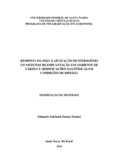| dc.creator | Hansel, Dâmaris Sulzbach Santos | |
| dc.date.accessioned | 2017-05-02 | |
| dc.date.available | 2017-05-02 | |
| dc.date.issued | 2015-02-28 | |
| dc.identifier.citation | HANSEL, Dâmaris Sulzbach Santos. Soybean response to nitrogen application in implantation systems in a lowland environment and modificatione modificações anatômicas em condições de hipoxia. 2015. 82 f. Dissertação (Mestrado em Agronomia) - Universidade Federal de Santa Maria, Santa Maria, 2015. | por |
| dc.identifier.uri | http://repositorio.ufsm.br/handle/1/5141 | |
| dc.description.abstract | Soybean has gained space in lowland areas. Where before had only irrigated rice, grows the interest for soybean, due to to rising issues on weed control and the interst for crop diversification in the same farm. However, the management used and the natural characteristics of lowland areas with rice cultivation collaborate for maintaining saturated soil in the field. Considering the cultivation of an upland crop, it is necessary that some management changes be done to benefit the establishment and development of the crop. In the first experiment different moments of broadcast Nitrogen (N) application were tested, in order to nurish the plant with the nutrient to help the biologic N fixation, that in saturated soils, is damaged. Also was used two seeding mechanisms, the conventional (offset double disc) and a mechanism that disrupts the compacted layer (planter shank) present in lowland soils. There was no difference between N application treatments. However, for the different mechanisms there was a difference in development and productivity, highlighting the planter shank. The second experiment was performed in the greenhouse also using cultivar TECIRGA 6070 RR, with the aim of observing anatomical modifications and their possible benefits among different time of saturation and vegetative stages. The aerenchymas were formed in the hypocotyl and roots, which were used as a survival mechanism by the plant when soil was saturated in the VC-V1 stage during six days, along with the adventitious roots. In the V6 stage, the aerenchymas showed better development, but due to tissue fragility and soil resistance, there was rupture of the atmospheric air conducting canals, formed by aerenchyma. This rupture occurred between the hypocotyl and the root, filling the canals with water and stopping the air conduction to submerged roots.In this stage the plant survived only with the support of the adventitious roots, formed on the plants hypocotyl. | eng |
| dc.format | application/pdf | por |
| dc.language | por | por |
| dc.publisher | Universidade Federal de Santa Maria | por |
| dc.rights | Acesso Aberto | por |
| dc.subject | Glycine max | por |
| dc.subject | Saturação | por |
| dc.subject | Baixo teor de O2 | por |
| dc.subject | Aerênquimas | por |
| dc.subject | Glycine max | eng |
| dc.subject | Saturation | eng |
| dc.subject | Low O2 rate | eng |
| dc.subject | Aerenchyma | eng |
| dc.title | Resposta da soja à aplicação de nitrogênio em sistemas de implantação em ambiente de várzea e modificações anatômicas em condições de hipoxia | por |
| dc.title.alternative | Soybean response to nitrogen application in implantation systems in a lowland environment and modificatione modificações anatômicas em condições de hipoxia | eng |
| dc.type | Dissertação | por |
| dc.description.resumo | A cultura da soja vem ganhando espaço nas áreas de várzea. Onde antes só havia o cultivo de arroz, cresce o interesse pela soja devido às dificuldades crescentes em relação ao controle de plantas daninhas e ao interesse pela diversificação de culturas. Porém, o manejo utilizado e as características naturais das áreas de várzea para o cultivo de arroz tornam difícil a drenagem. Em vista do cultivo de uma plantas em presença de lâmina de água, como a soja, é necessário que hajam algumas mudanças de manejo para beneficiar o estabelecimento e desenvolvimento da cultura. No primeiro experimento utilizou-se a cultivar TECIRGA 6070 RR e testou-se diferentes momentos de aplicação de nitrogênio (N) em cobertura, com o objetivo de fornecer à cultura o suprimento de N para auxiliar a fixação biológica de nitrogênio, que em ambientes saturados pode ser prejudicada. Também testou-se dois mecanismos de semeadura, o disco duplo e um mecanismo que rompe parte da camada compactada utilizando haste sulcadora, presente nos solos de várzea. Não houve diferença entre tratamentos de aplicações de N, possivelmente devido a não haver estresses hídricos. Porém para diferentes mecanismos houve diferença no desenvolvimento das plantas e na produtividade, destacando-se o mecanismo rompedor com haste sulcadora. O segundo experimento foi realizado em casa de vegetação utilizando também a cultivar TECIRGA 6070 RR, com o objetivo de mensurar modificações anatômicas e seus possíveis benefícios diante de diferentes tempos de saturação em diferentes estádios vegetativos. Os aerênquimas foram desenvolvidos no hipocótilo e raiz, os quais foram utilizados como mecanismo de sobrevivência pela planta quando o solo foi saturado no estádio VC-V1 durante seis dias, juntamente às raízes adventícias. No estádio V6 os aerênquimas apresentaram maior desenvolvimento, mas devido à fragilidade do tecido e resistência do solo, houve o rompimento dos canais de condução de ar atmosférico, formados pelos aerênquimas. Este rompimento ocorreu entre o hipocótilo e raiz, sendo inundado por água e cessando a condução de ar para pelos canais para as raízes submersas. Nesse estádio a planta teve a sua sobrevivência apenas com o auxílio das raízes adventícias, formadas no hipocótilo da planta. | por |
| dc.contributor.advisor1 | Marchezan, Enio | |
| dc.contributor.advisor1Lattes | http://buscatextual.cnpq.br/buscatextual/visualizacv.do?id=K4793251A2 | por |
| dc.contributor.referee1 | Lange, Claudia Erna | |
| dc.contributor.referee1Lattes | http://lattes.cnpq.br/4535541088454396 | por |
| dc.contributor.referee2 | Giacomini, Sandro José | |
| dc.contributor.referee2Lattes | http://buscatextual.cnpq.br/buscatextual/visualizacv.do?id=K4794885J2 | por |
| dc.creator.Lattes | http://lattes.cnpq.br/0506065499394862 | por |
| dc.publisher.country | BR | por |
| dc.publisher.department | Agronomia | por |
| dc.publisher.initials | UFSM | por |
| dc.publisher.program | Programa de Pós-Graduação em Agronomia | por |
| dc.subject.cnpq | CNPQ::CIENCIAS AGRARIAS::AGRONOMIA | por |


